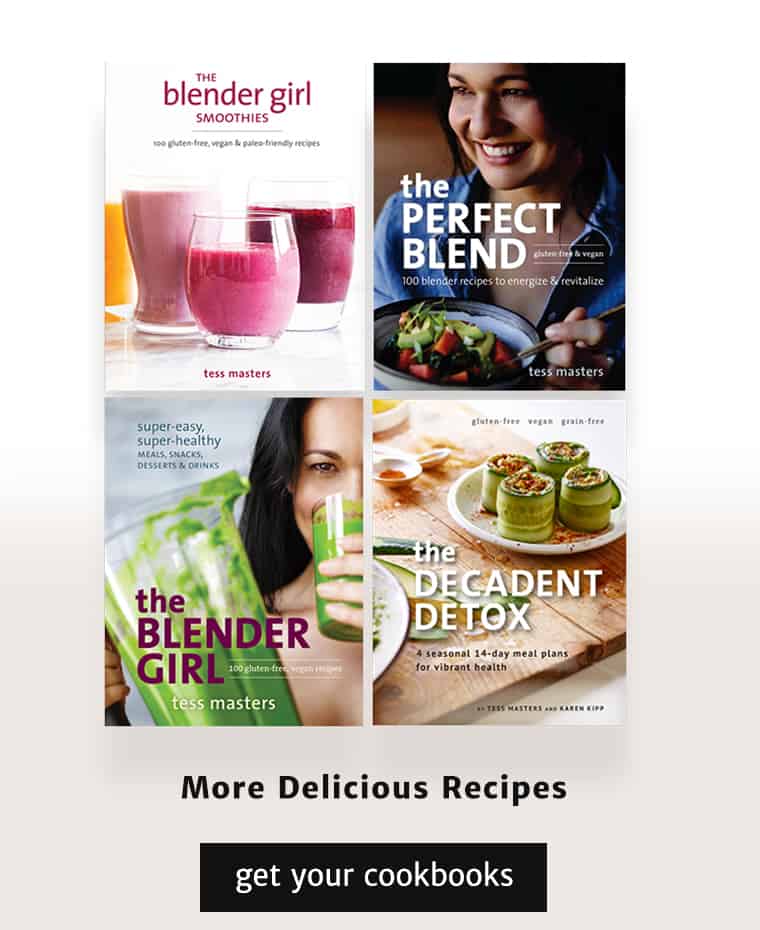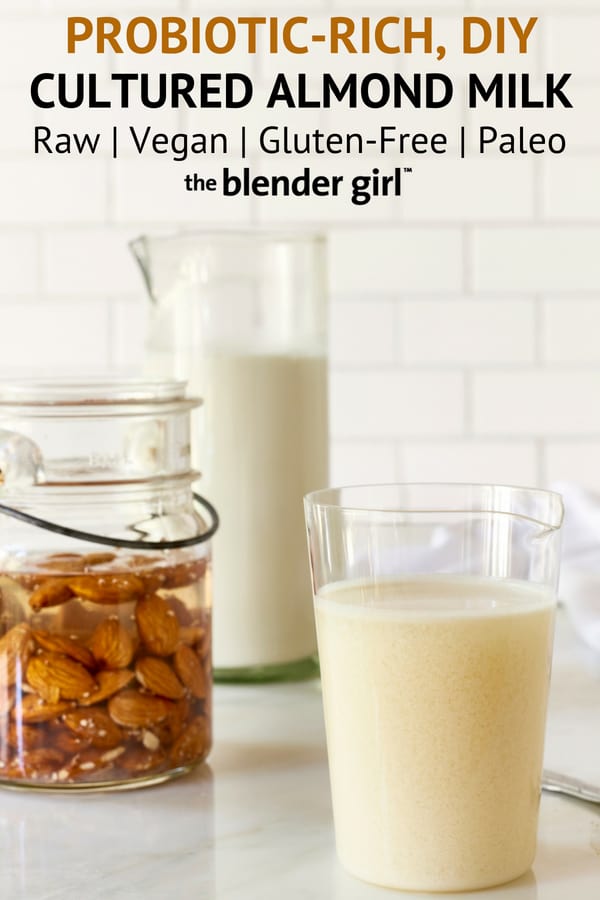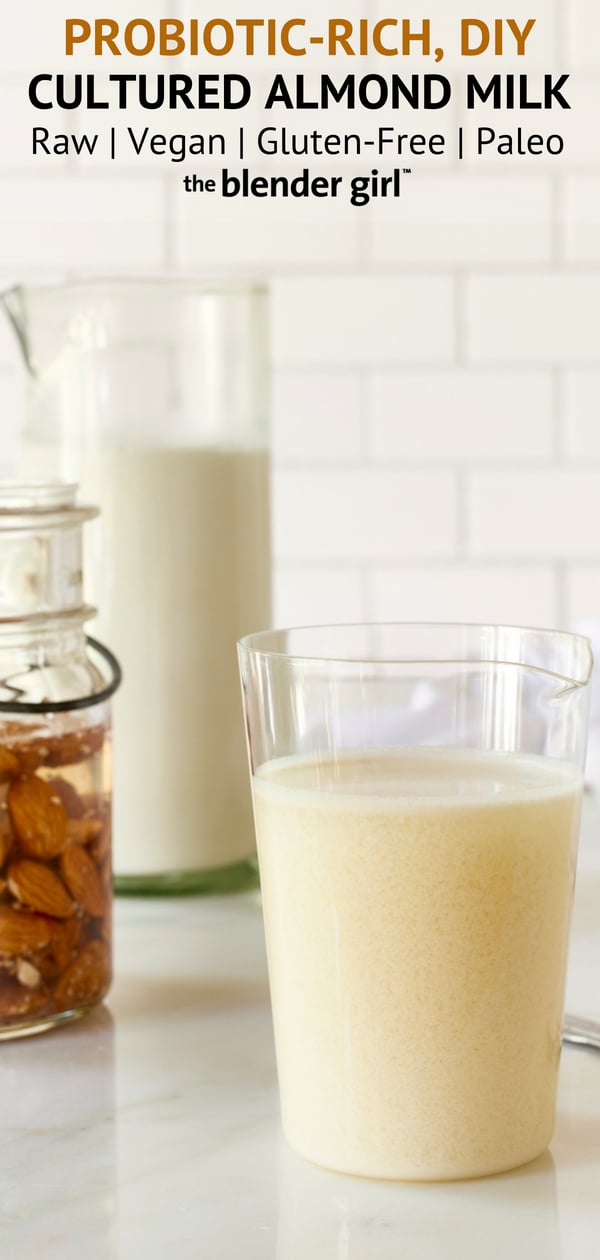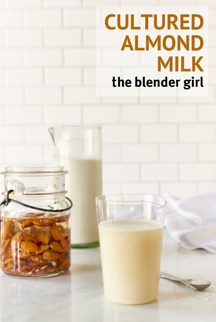Almond Milk “Kefir”
February 26, 2013
This almond milk kefir is easy and has a lovely tangy flavor. Drink this probiotic beverage in the morning or evening or add to smoothies.

Almond Milk Kefir
This almond milk kefir is really easy to make, is has a lovely tangy flavor. Drink this probiotic beverage in the morning or evening or add to smoothies.
Ingredients
- 1 cup raw almonds
- 3 cups filtered water
- 1/2 teaspoon (1g) probiotic powder
- 2 teaspoons (10ml) fresh lemon juice, plus more to taste
- 1/2 teaspoon 2.5ml) apple cider vinegar, plus more to taste
- 1/2 teaspoon (2.5ml) natural vanilla extract
- 1 chopped pitted date, plus more to taste
Instructions
-
Throw the almonds and filtered water into your blender, and blast on high for 30 to 60 seconds until the almonds are pulverized.
-
To strain the milk, place a nut milk bag over a large mason jar, bowl or jug, pour the milk in, and gently twist and squeeze the bag until all the liquid has passed through.
-
Transfer the milk to a large mason jar. With a non-reactive spoon (wooden or plastic), stir in the probiotic powder. Cover the jar with a breathable cloth, and leave on the counter at room temperature for 12 to 24 hours, until the milk develops a slight skin, and is a little tangy.
-
Pour the "kefir, lemon juice, apple cider vinegar, vanilla, and date into you blender, and blast on high for 30 to 60 seconds, until smooth and creamy.
Recipe Notes
SOAK YOUR ALMONDS
The almonds need to be activated for better digestion. I recommend using dry activated almonds (not wet) so that the milk lasts for up to 5 days. If you use wet long-soaked almonds, the milk will last for 2 to 3 days. For specific instructions, read the Activating Foods page.










Comments 77
Awesome! I’m a total kefir addict, so I’ll have to try it. 🙂
Me too! I love coconut water kefir and this almond milk kefir. This is AMAZING in smoothies. Enjoy 🙂
hi there,
oink oink!! i get probiotic tablets that have 100 billion bacteria per capsule.. would i still use 4 or just maybe 2??
also is the capsules content/bacteria the same as “cultures” you get to make yoghurt?
thanx blender girl 😉
I would still use 4 to be safe. The capsules I used were really powerful too. Yes, you can absolutely make yoghurt this way too. I make raw coconut yoghurt this way all the time! YUMMO! Enjoy 🙂
I thought kefir was made with kefir grains not probiotic capsules. ??
Yes, traditionally it is made with kefir grains. Please read my whole post where I explain everything in detail.
I read the whole post. It really is not kefir if you don’t use kefir grains. It’s a yoghurt drink. Much like what you can buy in Turkey.
OK. Catriona. I have put the kefir in “” for you. I have called it cultured milk. But, this is still the most accessible and easiest way to culture milk for people who don’t want to buy grains.
There are many people who give grains away.
True! Thanks for sharing the tip!
do you need to skim the fat off the top and strain?
can one just re-miz it all together and drink as a thicker milk?
thanks
You can reblend together. However, you will get some bits as it sits that may not be desirable. But, if you don’t mind that, I say, go for it and enjoy 🙂
I’m curious as to which probiotic brand you use? I just purchased some New Chapter All-Flora probiotics after reading a recipe for vegan cheese in the book “The Concious Cook”. I’m interested to hear which type of probiotic you like to use.
There are quite a few on the market that are good. The Jarrow Formulas 5 Billion capsules are amazing. The Solaray Multidophilus 20 Billion capsules are also good. You can also use the powders. I always empty the capsules anyway. I never swallow the capsules. I hope this helps.
That sounds amazing!! 🙂
But I have a question: do I need to use almonds, or could I try using cashews, hazelnuts, macadamias or other nuts/seeds too?
Greetings from Austria! Bettina
You can absolutely use other plant based milks and use this same principle to make yoghurt “kefir’. I just like coconut and almond because they are alkaline and have mild flavours. Let me know how you go!
Hi!
Great recipe! I was wondering if I could also make this kefir with a yoghurtstarter with Bifidus bacteria?
Hey Johanna,
Yes, you absolutely could. Enjoy 🙂
Thank you for the quick reply.
I took a taste this morning and it was a succes 🙂
Wonderful! Thanks for taking the time to come back and share your experience. It is so helpful to others. Enjoy 🙂
Hi there! Was wondering, does this need to be done in a vitamix, or would I be able to make using a traditional blender/food processor with same results? Thank you!
Rachel, you can absolutely make this in a conventional blender. You will just have to blend for longer and pulverize as much as possible and then strain.
I make almond water kefir with water kefir. Instead of water, I use water kefir since I brew it and grow the grains. Comes out great!
Awesome! Love that Barbara!
Barbara, can you explain that more please? I make water kefir myself and am curious what exactly you are making! I’m always wanting to learn.
MaryEllen – you blend the almonds with the water kefir instead of plain water.
But where do you get the vegan water kefir to begin with?
I keep reading about kefir, but it seems one needs kefir to make kefir. .. I’m so confused.
Does one just buy the kefir grains and make kefir water like almond “milk” is made? If so, where did those kefir grains come from to begin with? And can I find vegan kefir grains?
I hope I get a response, because this has truly baffled me.
<3
But where do you get the vegan water kefir to begin with?
I keep reading about kefir, but it seems one needs kefir to make kefir. .. I’m so confused.
Does one just but the kefir grains and make kefir water like almond “milk” is made? If so, where did those kefir grains come from to begin with? And can I find vegan kefir grains?
I hope I get a response, because this has truly baffled me.
<3
Marce, you can make coconut water or water kefir by using kefir grains which you can purchase from Cultures For Health. But, with this cultured almond milk you can just use probiotic powder. That is why I posted this easier recipe, to make it more accessible. If you still have questions, please feel free to email me through the contact form of the site, and I will get back to you.
Thanks for sharing your resource and advertising your site here.
sonia regina
Please, I didn’t understand. I make kefir with raw almond milk (7 or 8 cups water?
Yes. I make regular almond milk with a 1 cup almonds to 3 cups water ratio. But, for the purposes of almond milk kefir you will get the best results with a more diluted solution. So, 7 cups is best.
Why so complicated? Can I just use commercial almondmilk and the kefir grains that I already have? I guess something sweet needs to be in there, so maybe for kefir purposes I need to buy the sweetened kind….
I make this all in less than 10 minutes, so I don’t find it complicated. I also find that the probiotic powder yields to most uniform results. However, I do love kefir grains and use them to make water kefir. I was trying to make this accessible to people that don’t have kefir grains. You can absolutely use kefir grains in this recipe. I don’t like to use commercial almond milk because it contains additives, preservatives, and no live enzymes. You also don’t need a sweetener when you use probiotic powder which technically isn’t “kefir” but is still cultured.
Hi, could you provide a couple of probiotic powders you would recommend? The one you link to in the recipe has been discontinued. Thanks!
Christie – I like the VSL 3 brand or Solaray.
I’m very excited to discover the idea of non-dairy Kefir. However, I’m curious, what are the added benefits of making kefir as a means of consuming the probiotic powder versus just taking the probiotic capsules daily? I saw you mentioned you never take the capsules. Why is that?
I love the taste of kefir or cultured milk, and think it’s a tasty tangy way to get your probiotics. It’s also a living probiotic-rich food. You can absolutely add probiotic powder to smoothies or dissolve in water or milk. I don’t use the capsules because the outer coating can be difficult to digest. If you have capsules, simply break them open and consume the powder.
Hi. I can’t access the link in this sentence: “Those of you who have been following me for a while would be familiar with my life-long battle with candida. You can read more about my personal story here. “
Sorry Dee, there was a glitch to my about page. I have just fixed it. Thanks for your interest.
Hi, thank you very much for this post! I wonder if I could just blend 2 tablespoons of almond butter with 3 cups of water to make almond milk, and add some probiotics powder? I am thinking of getting Healthforce Nutritionals probiotics as it is vegan. Has anyone tried this method or used this brand of probiotics? What if I use home made rejuvelac to blend with the almond butter? Thanks for your reply.
Jen, you can make quick almond milk by blending 3 tablespoons raw almond butter with 2 to 3 cups of filtered water. I haven’t made cultured milk this way, but I don’t see why it wouldn’t work. I haven’t tried the Healthforce probiotics.
can this be done with store bought almond milk? or is that over processed?
No, I don’t recommend using commercial milk. It has a higher water content, and contains so many additives and preservatives. You can use it, but it’s really devoid of any nutrient benefits.
The Recipe is so delicious and tasty. I have tried many such similar recipes but none have worked so great for me. Thanks a lot for those detailed and step by step instructions that made it easier to get the job done in no time.
Great! I’m glad you enjoyed it.
Thank you so much for these instructions which I have just completed. My question is, and I hope that it hasn’t already been answered above ( don’t have time to read everyone’s comments), if the fat/scum is to be eaten, is there a particular reason that it needs to be skimmed off, rather than stirred back into the mix?
Many thanks ,
Clare
The fat scum just never really incorporates back into the milk which is why I recommend skimming it off. But, you can totally drink it/eat it with the kefir. I put it in smoothies.
Hi, I’ve always wondered about blending probiotics (or in this case almond “kefir”) into smoothies. I have a Blendtec and for some reason I worry that it’s blending force will somehow destroy the probiotics? Or like you say not to use a metal spoon to stir the probiotics into the milk. What about the metal blades in the blender? Also, do you happen to have a link to a study showing metal damages the probiotics? I’ve been using a metal spoon to stir mine into water daily. Can’t wait to try this recipe asap!
Yes. But, you blend to make the almond milk mixture first, and then you add the probiotics, so you don’t need to worry about the blender blades. So, it’s all good! Enjoy!
My question is if at room temperature that the culture will really thrive and multiply well enough. I make scd yogurt and it has to be kept between 100-110 degrees to culture well. Also if you use a non dairy source, there are no enzymes to encourage growth so I have read you have to use honey to get the probiotics to colonize and multiply.
I’ve tried this at various temperatures, and the probiotic capsules fair very well. If you’re in a cold climate and concerned, insulate your bowl with towels, and put it in a warm space.
Hi, I was wondering if it is absolutely necessary to strain the milk after blending the nuts or can you keep it “whole” and thicker and not strain. Just curious. Can’t wait to try!
You can keep it whole and not strain the pulp, but add another probiotic capsule to account for the extra material. Just know it will be quite thick and fibrous. Enjoy!
Hi Tess, considering I haven’t embarked on the kefir regime yet and this makes more than I can consume as a beginner (1/4 cup pee day), can I halve this recipe?
Yes, absolutely.
Hi, I have made this 3 times now and with no difference of method on each occasion. The last 2 times however, my mix had developed a ropey, stringy consistency. The first time it did this, I had had to go away for a few days shortly after making it and thought that it may have just gone off. But this week it was the same again immediately after making it, so that I know that everything was still very fresh. Can you explain why this might be and whether this is normal and/or still safe to drink, please? Many thanks in advance, Clare
I think different probiotic strains have different charachteristics and one that you are using develops like this. Have you seen the natto strains from fermented soybeans are very stringy.
Thanks Phil, I was going to say the same thing. I would not be alarmed. Just skim and strain the mixture. I hope this helps.
I just made the almond milk and blended for 2 minutes, as stated in the recipe. I noticed the milk was quite hot, and measured 40 degrees Celsius. Would it be better to wait a bit for the liquid to cool down, or do the probiotics tolerate the temperature?
I’m so happy I just found your recipe, as I just had to take antibiotics! Thank you!
Great point Michaela. Thanks for bringing this up. Yes, wait for the milk to cool down a bit before adding the probiotics. So happy you’re finding this recipe useful.
kefir, by international dairy standards, must be inoculated in dairy from a lactating mammal. Thus, your use of “kefir” is incorrect. great recipe, though!
Yes, thankyou Bridget. I am aware, and have that disclaimer at the bottom of the post. That is why it’s in “”. Cultured Almond Milk is more accurate. But, I was receiving hundreds of emails asking what that was, so I called it “kefir”.
I just read the ingredients for the jarrow veggie caps and it contains trace amounts of milk and soy. Do you know of another to use?
Custom Probiotics has a vegan variety that is good.
I will admit that I did not read all the comments here, so if I am repeating myself I apologize. Can I use kefir grains instead of powdered probiotics to start my kefir?
You can absolutely use kefir grains to culture this milk. You can purchase them from Cultures For Health. I just offer up probiotic powder as a more accessible, quicker, easier way to culture almond milk. But, both methods work to make probiotic-rich beverages.
I made this recipe, im used to drink dairy kefir, so its pretty dense and thick. My almond kefir looked just like yours, but it tastes quite different from what i expected. It is also very liquid. So what it is supposed to taste like? I am afraid that is fermented tasting ? it also smells pretty strong. how do i know that is good, and not fermented ( i mean i know it is supposed to be fermented) but like when almond milk goes bad fermented! I don’t want to get sick.
Maria, I’m so sorry it took me a while to respond to your question when I know it’s already too late to advise you on the batch you made. I was travelling. Almond milk kefir is thinner than commercial kefir, and it does have a tangy flavor. It should taste fermented, but you don’t want to to leave it too long so that it goes really sour. As long as you haven’t left it out in extreme heat, it shouldn’t make you sick. Ferment the almond milk, then place it in a sealed container in the fridge. It should be fine. I hope that helps you.
I’m wondering how this food combines (according to the Body Ecology Diet). Would it only combine with nuts, seeds, avocados, sour fruits, leafy greens? Or since it is fermented, does it combine with anything? Thanks so much!
Great question. I’d still only combine it with other nuts, seeds, fruits, leafy greens, and avocado just to be sure. I’ve been on Body Ecology Stage 1, and you wouldn’t want to do anything to mess up your progress. I will ask Donna about this next time I see her.
I used this recipe on walnut and also hemp hearts, so yummy it is. Thin but I like it alot.
I’m glad you’re enjoying it. Yes, this blend is thin, but it’s potent.
Can I use regular kefir grains and add them to unsweetened almond milk? Would this work?
Yes, absolutely. That would be the more traditional way to make kefir. Be sure to use homemade almond milk.
I bought kefir sachets from health food shop, can I add this to almond milk? A little confused if I need to start with milk first, not a fan of whole milk